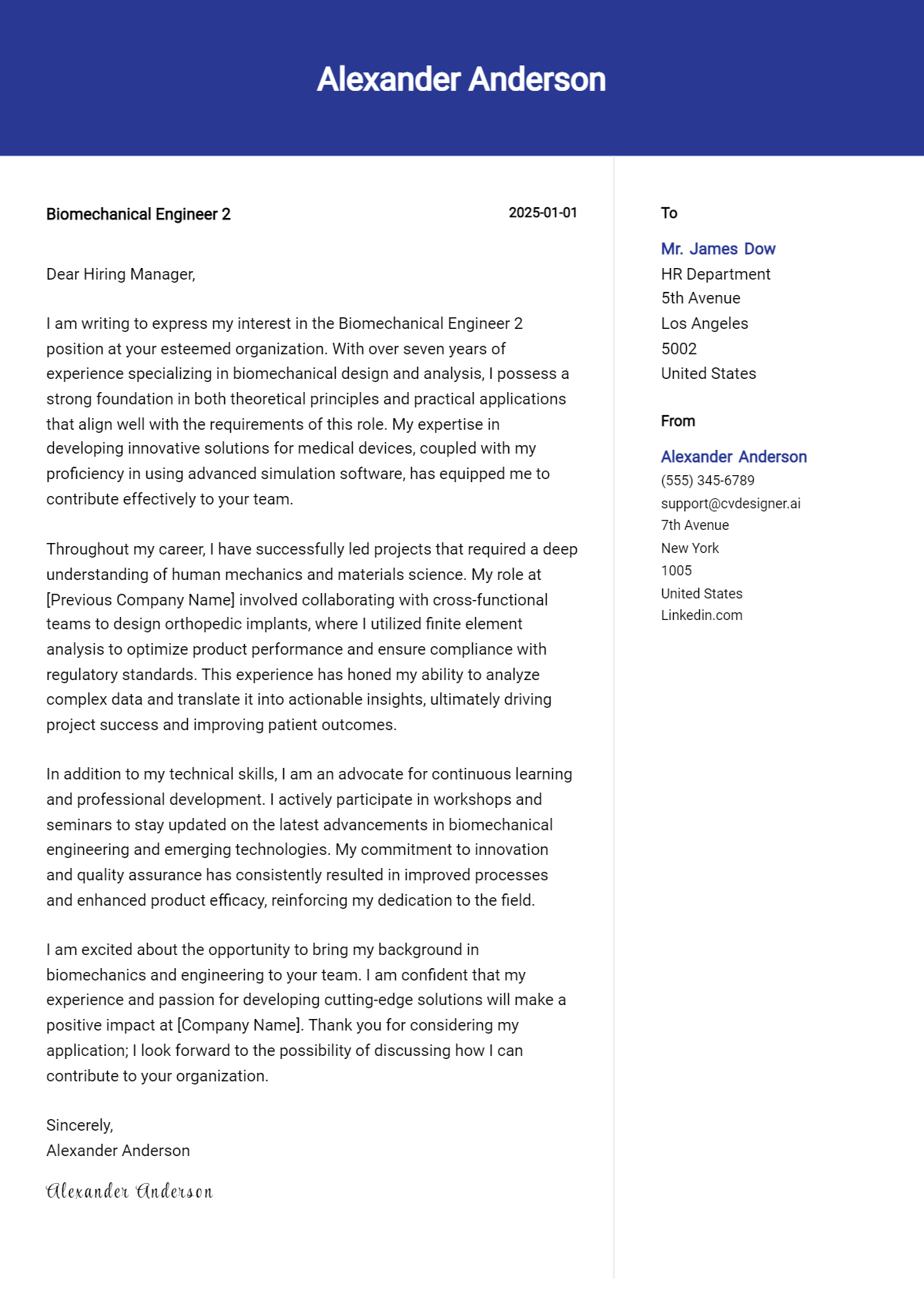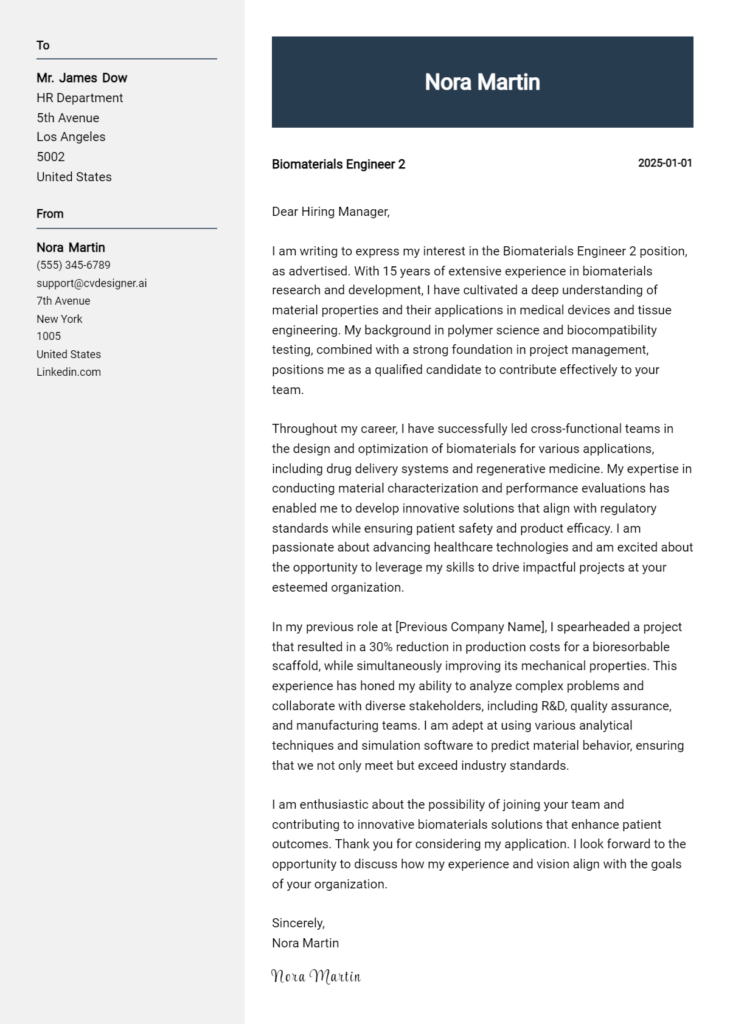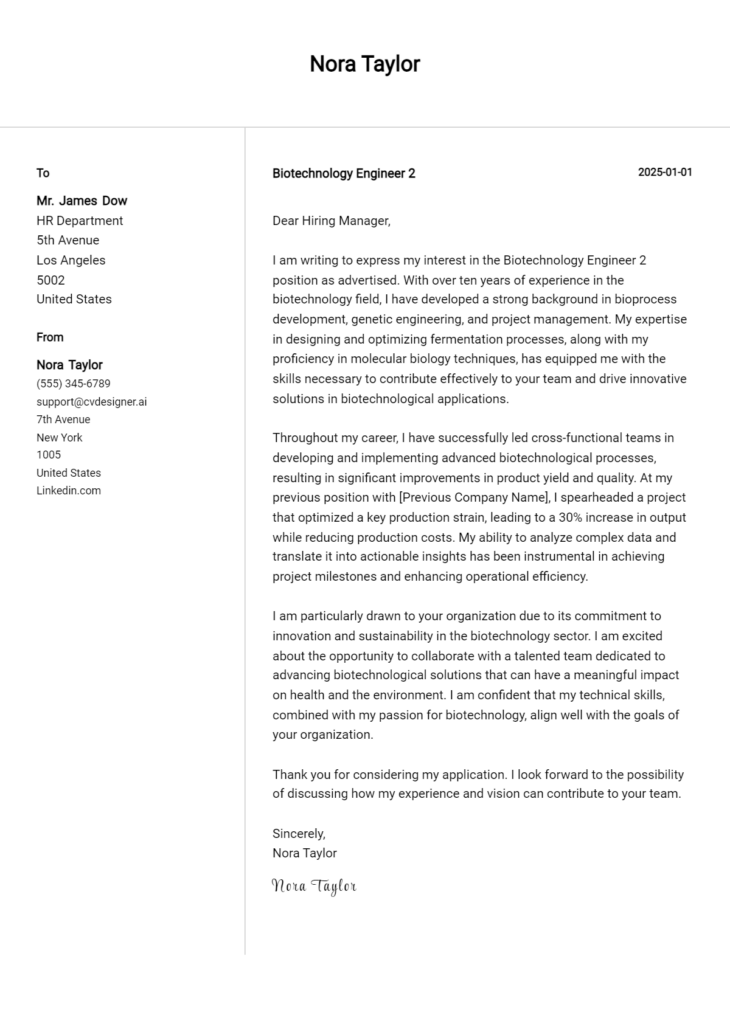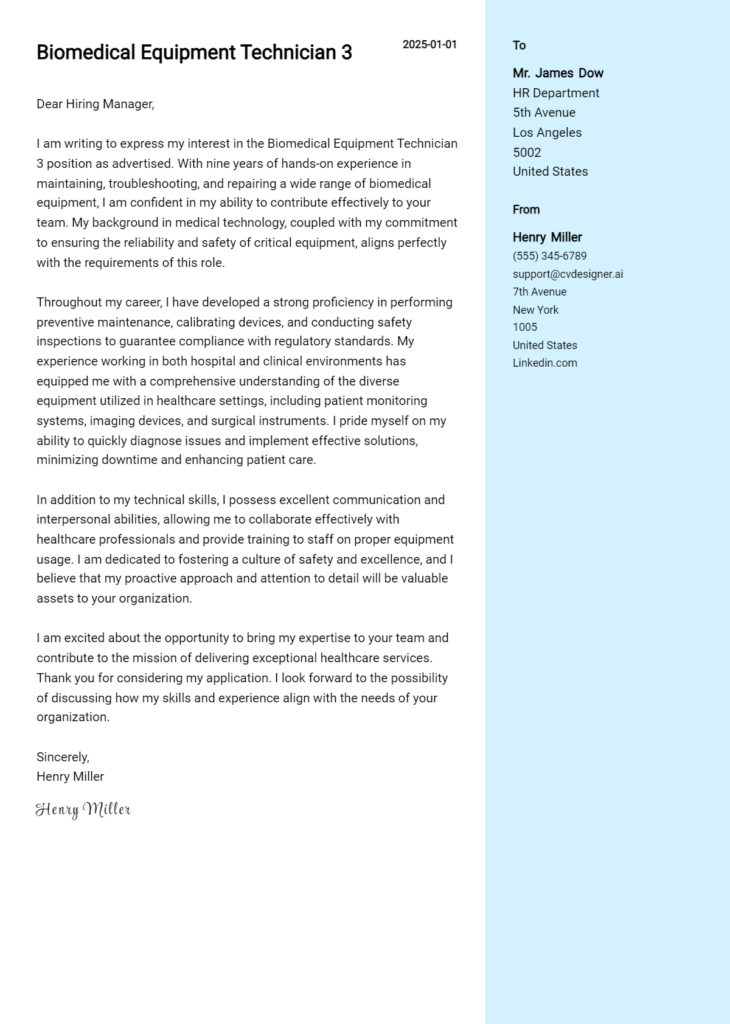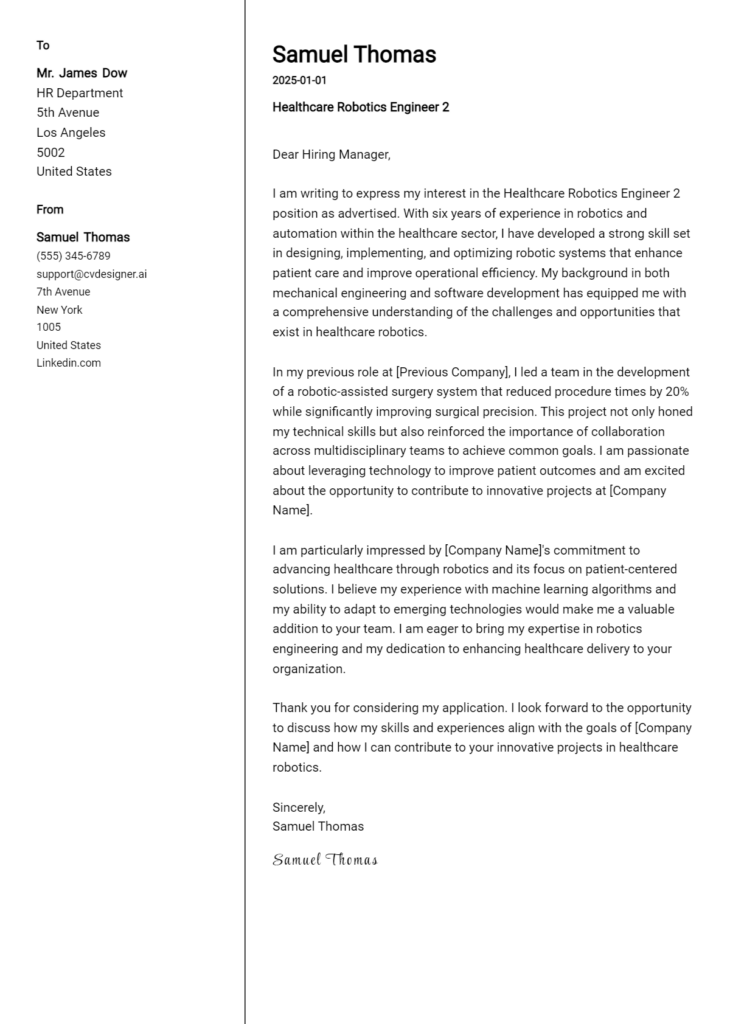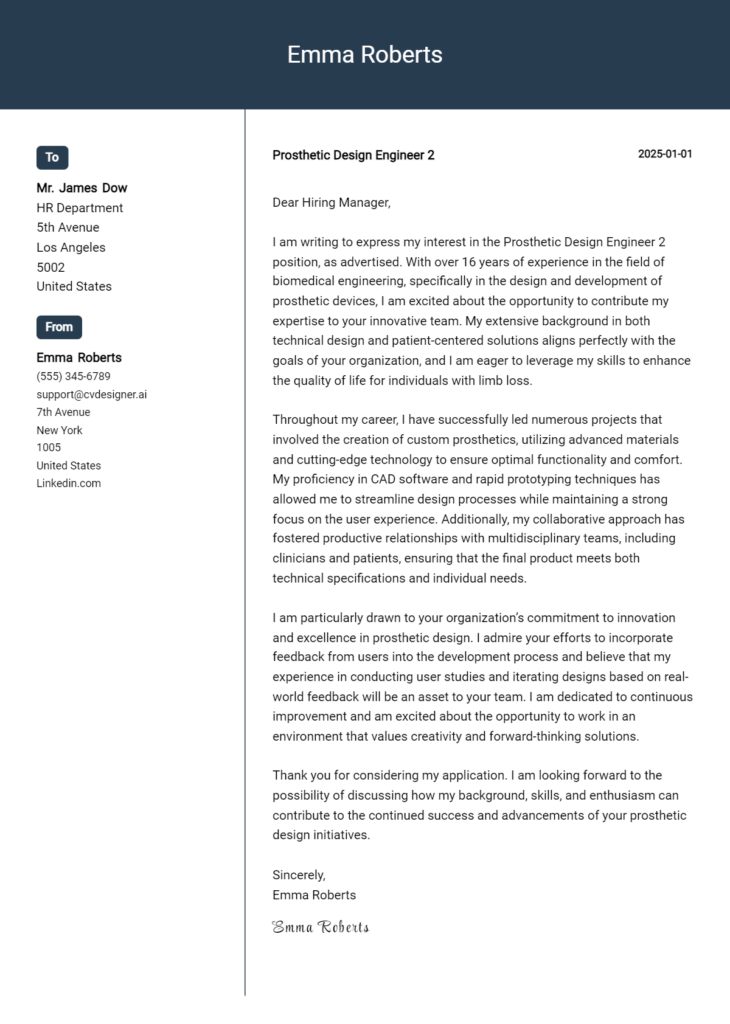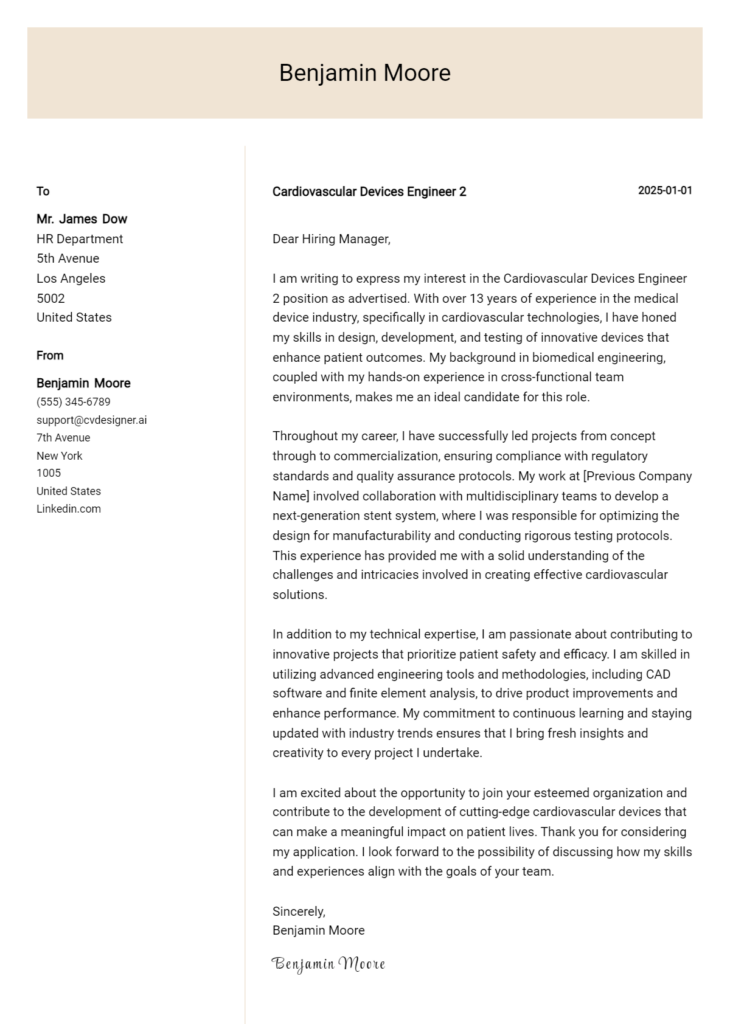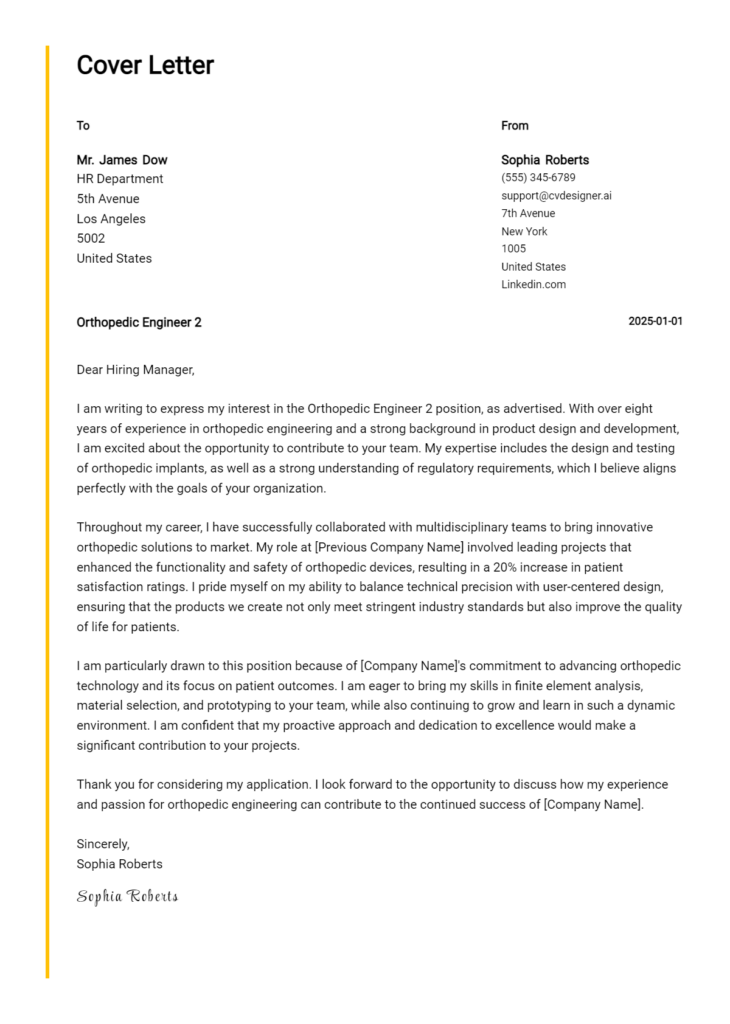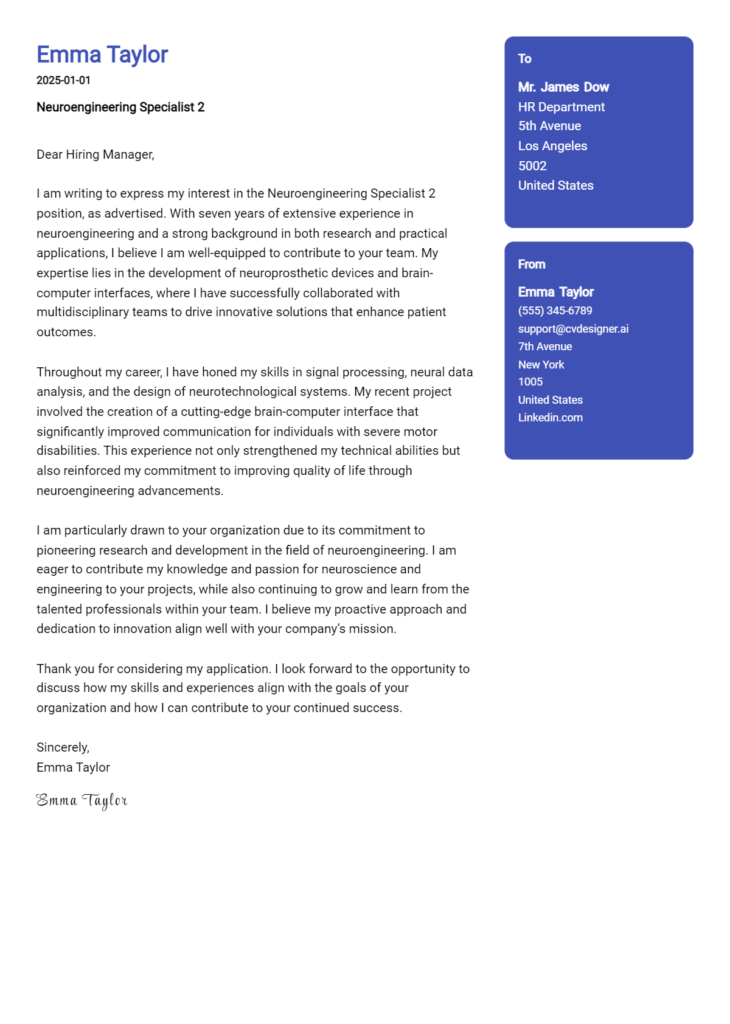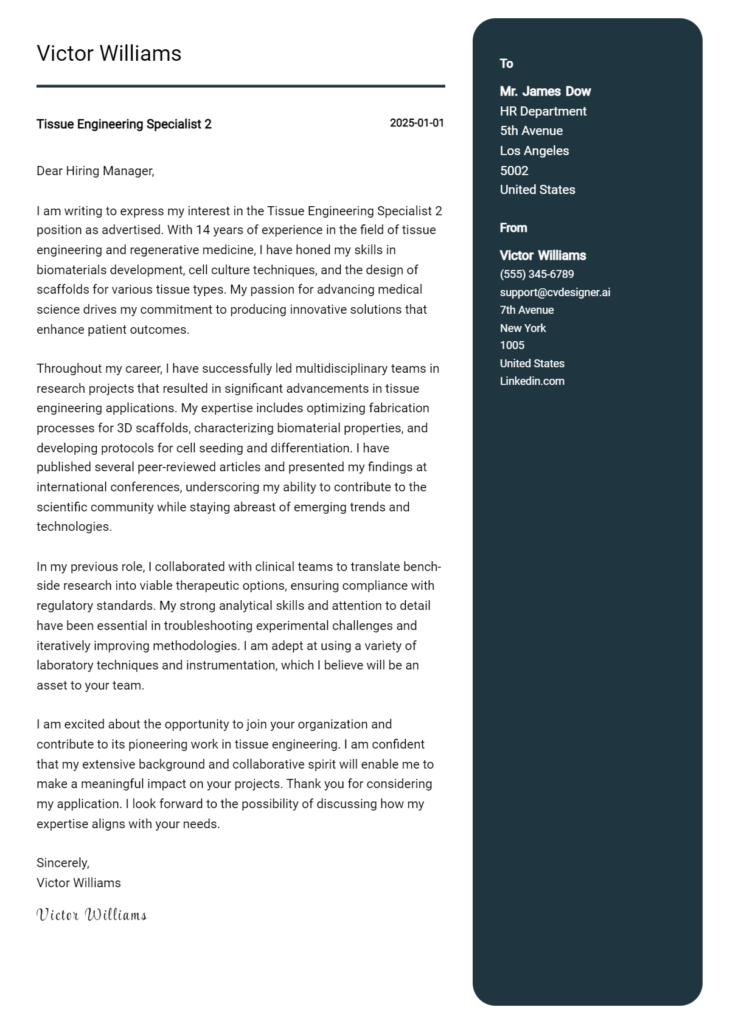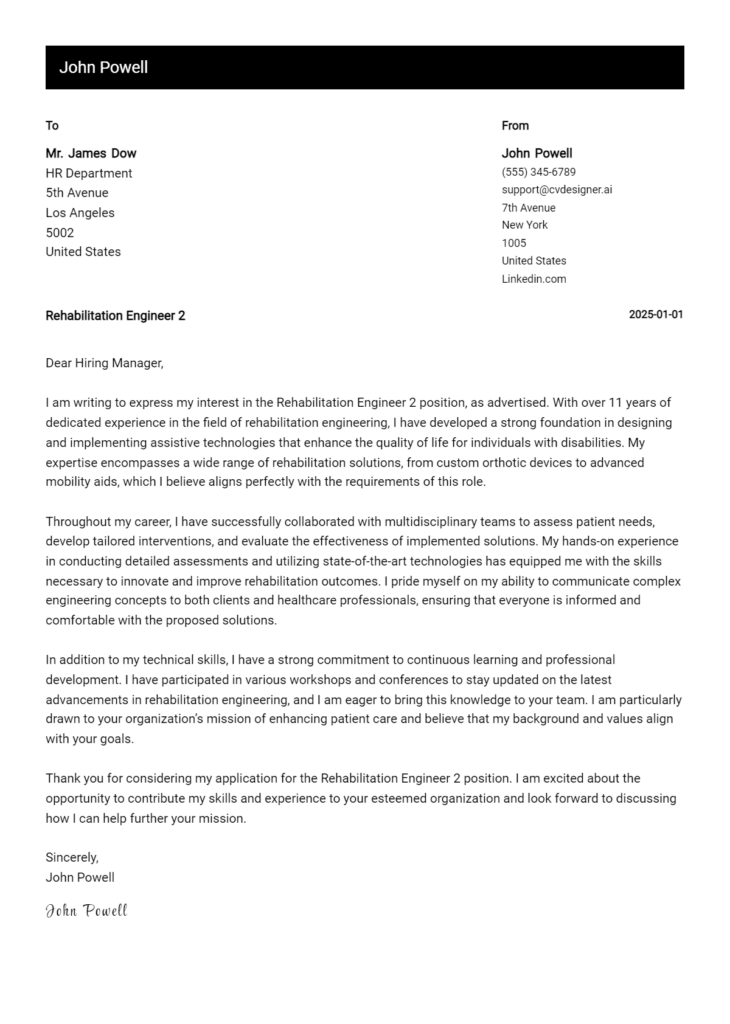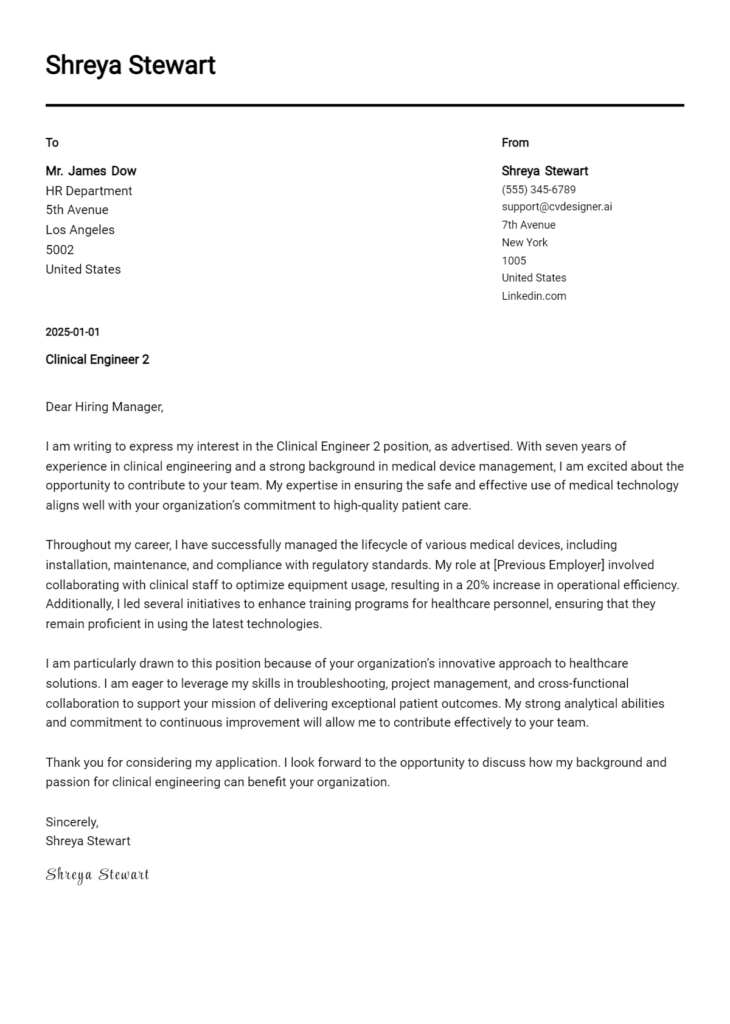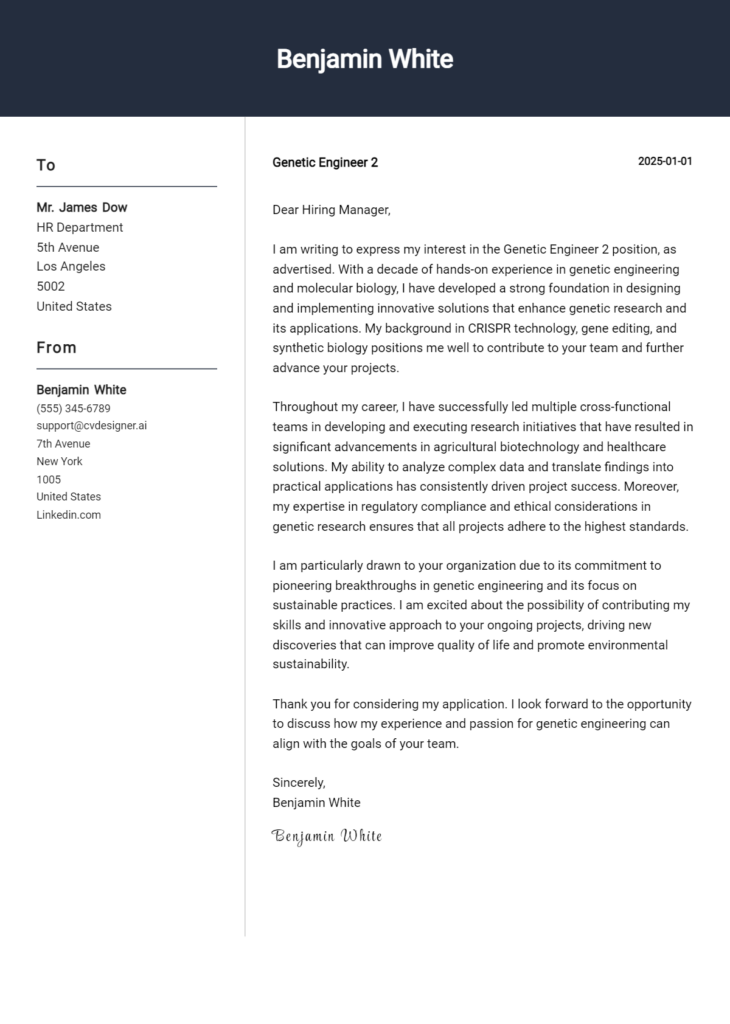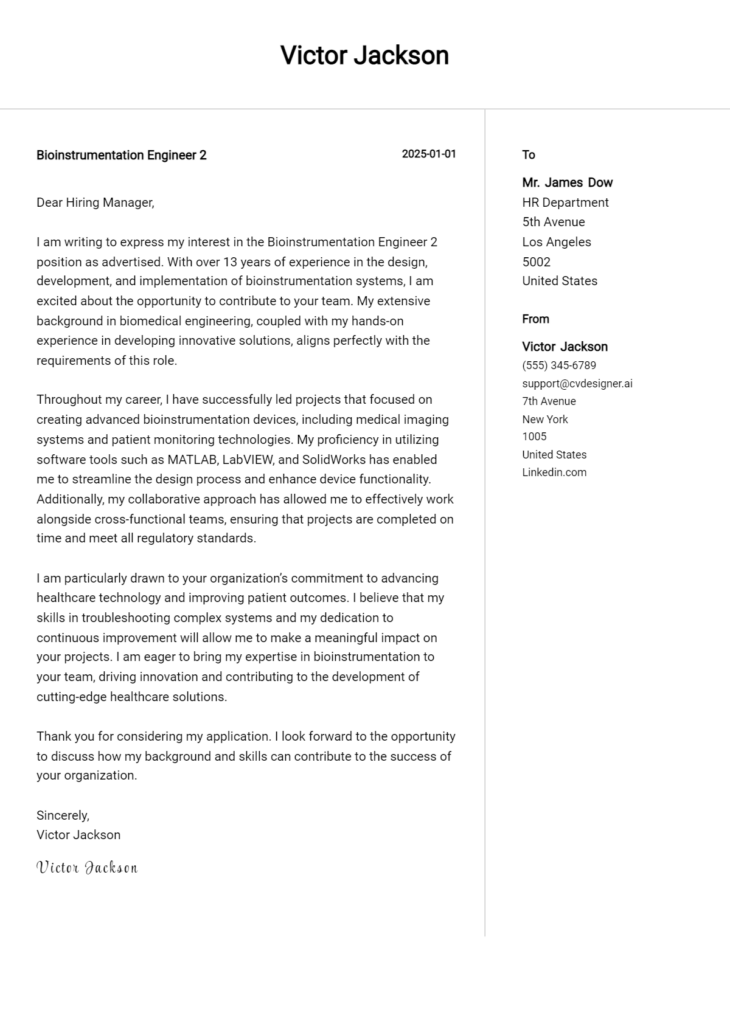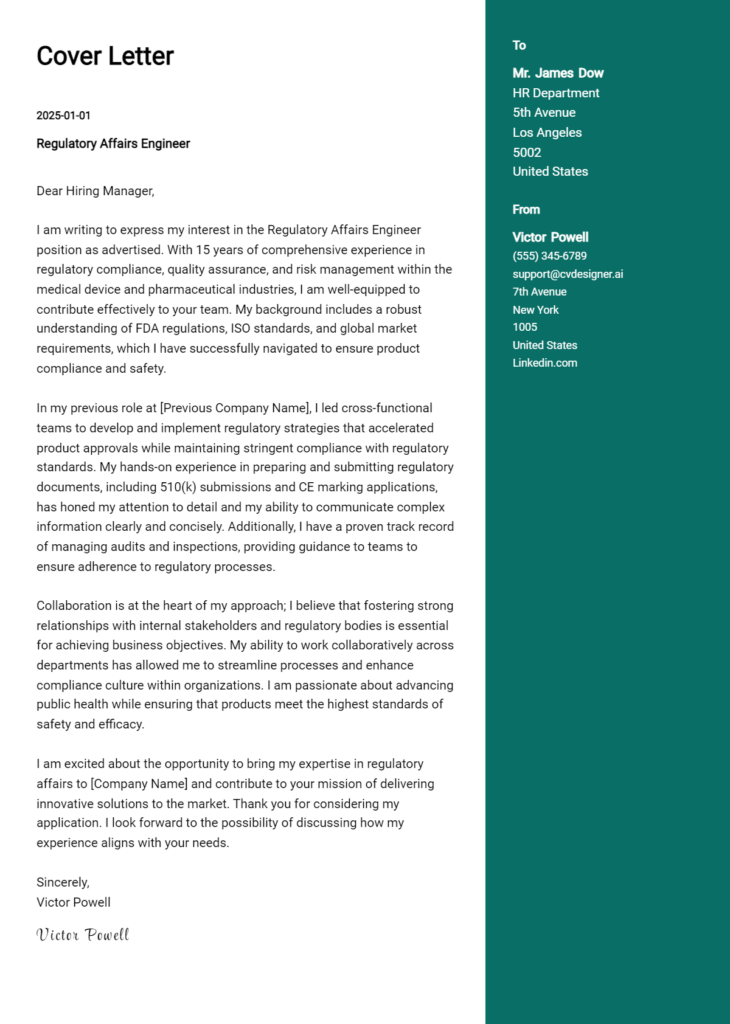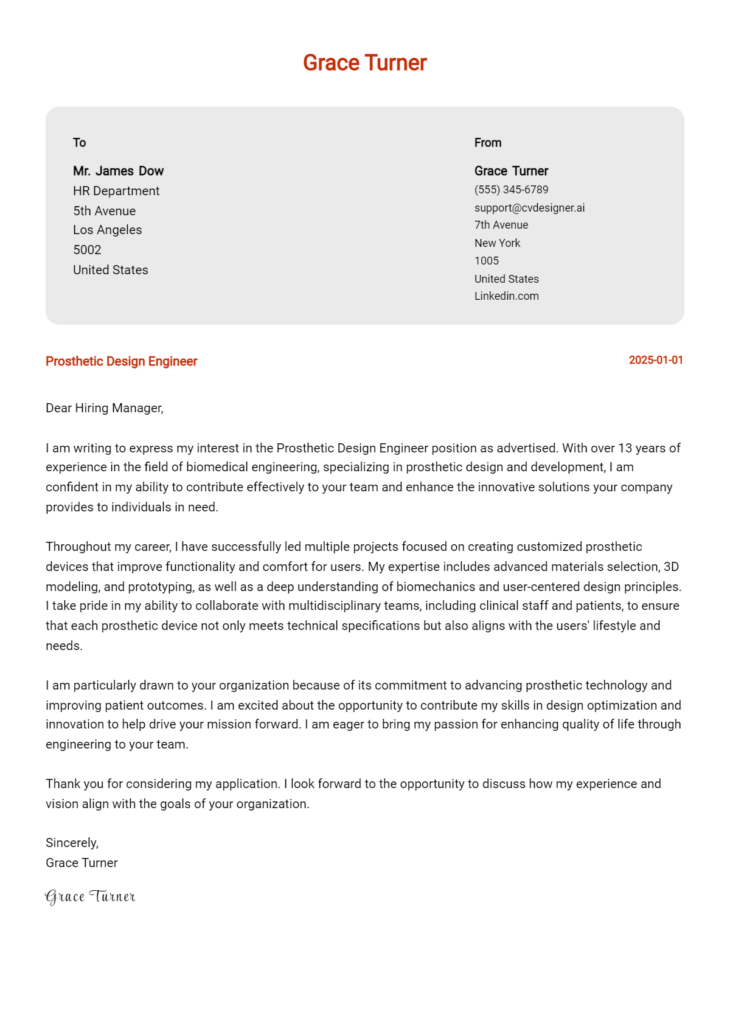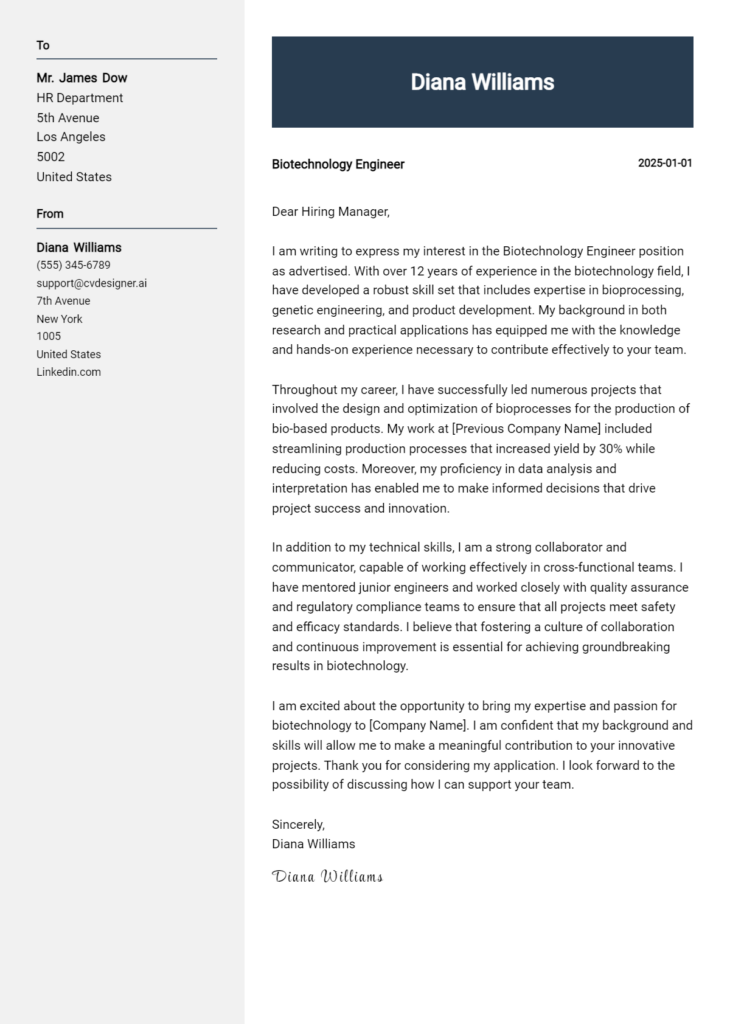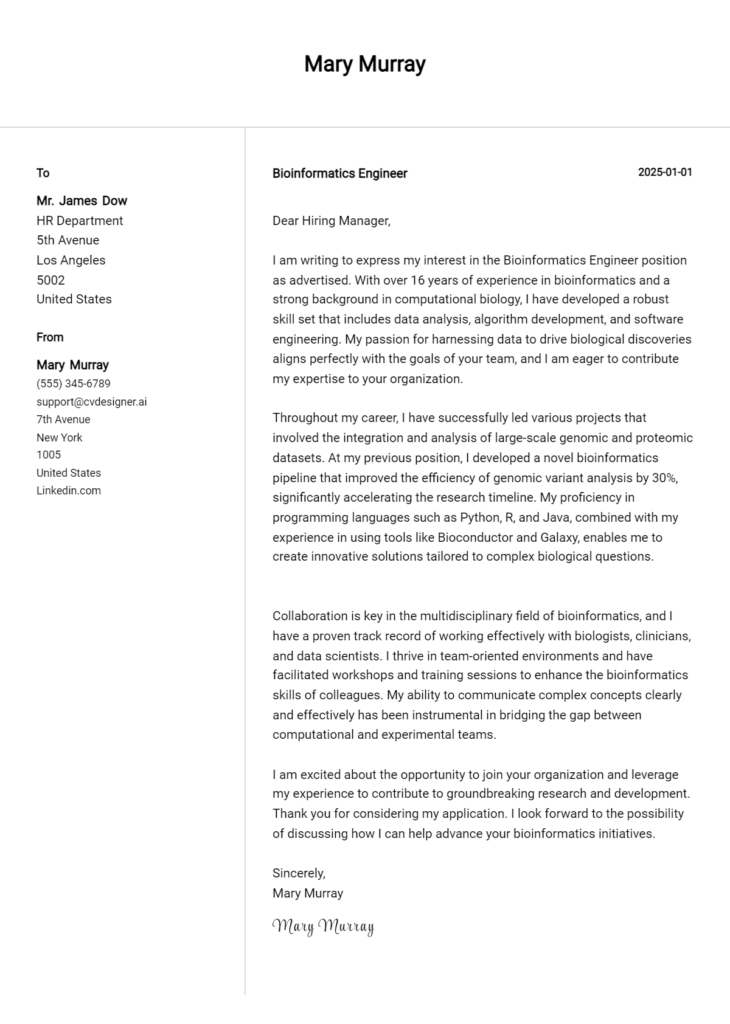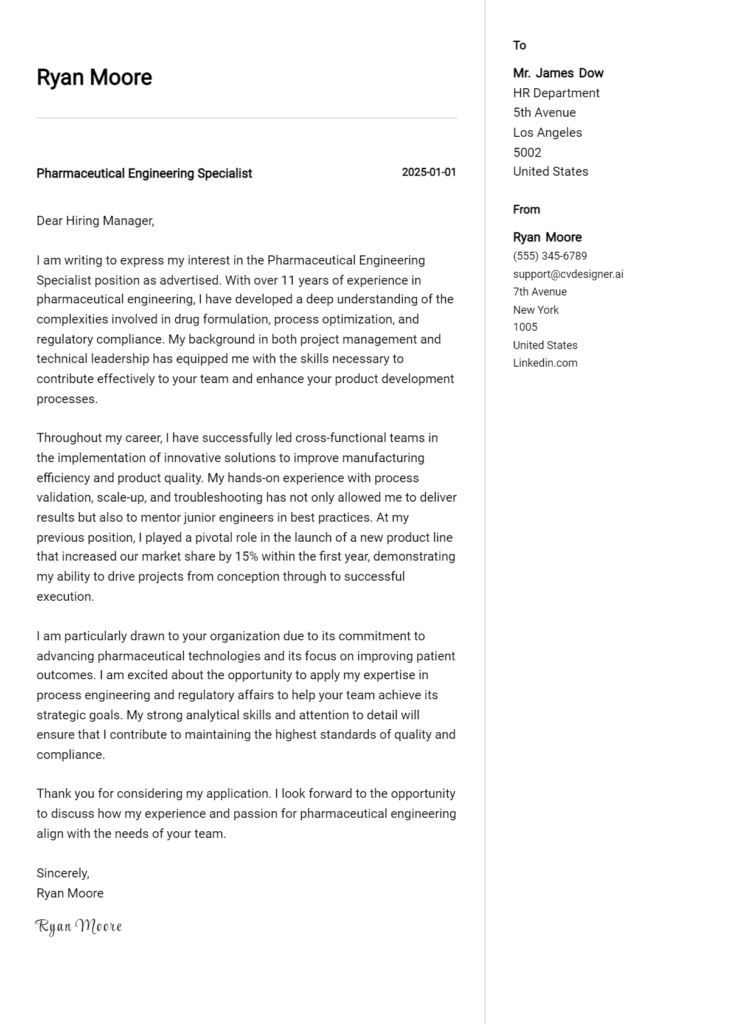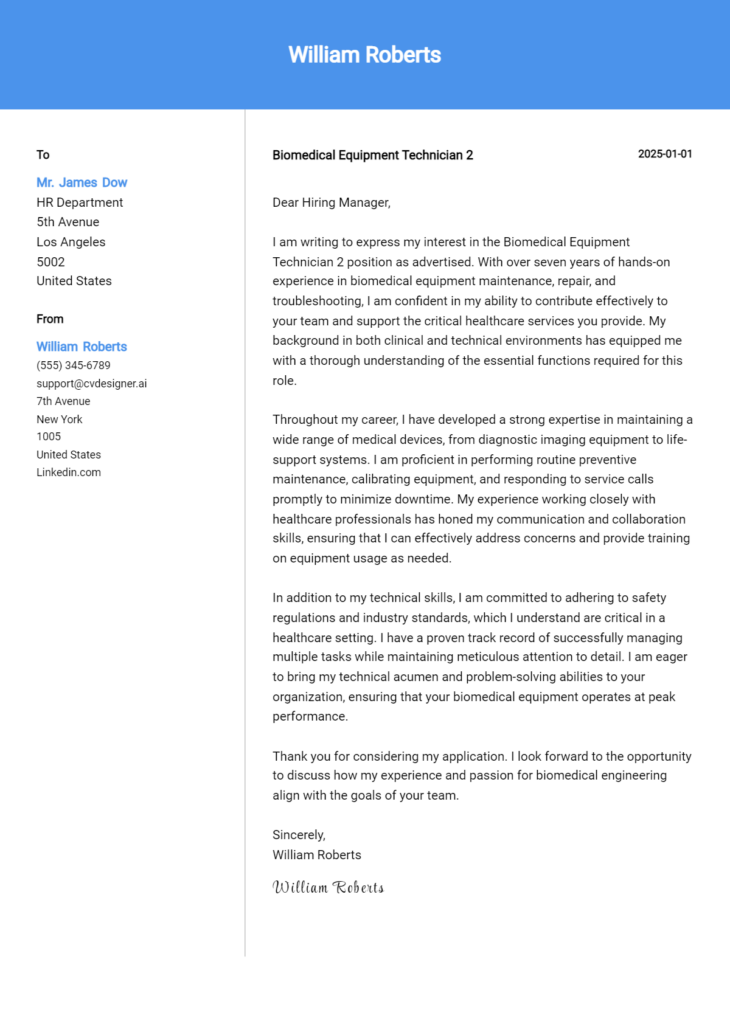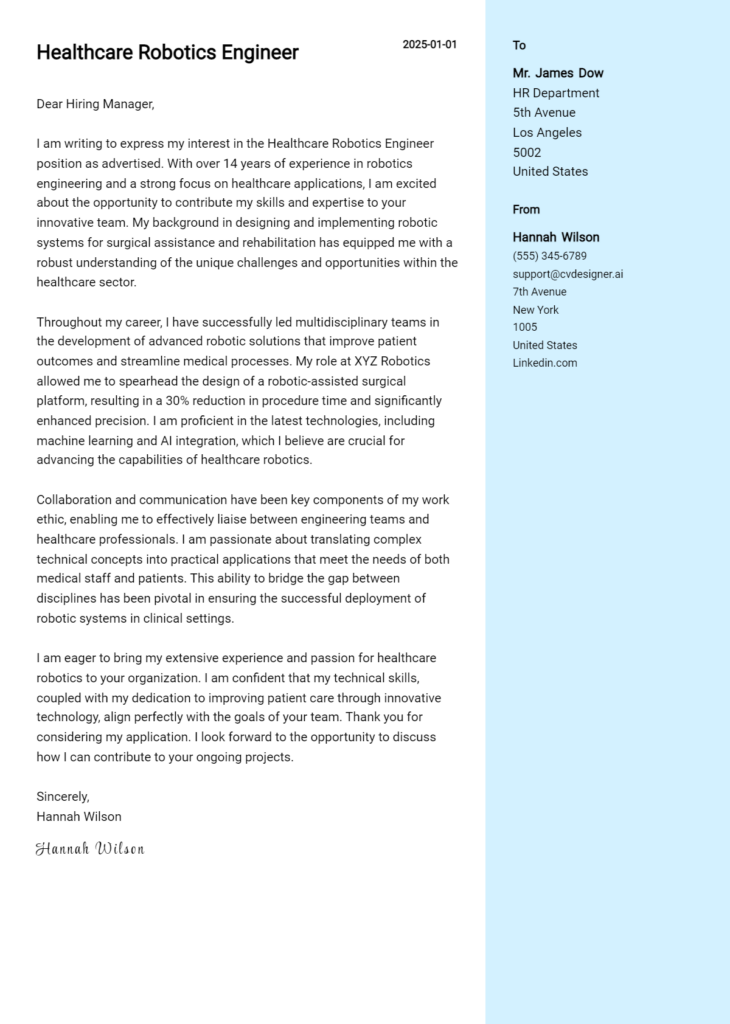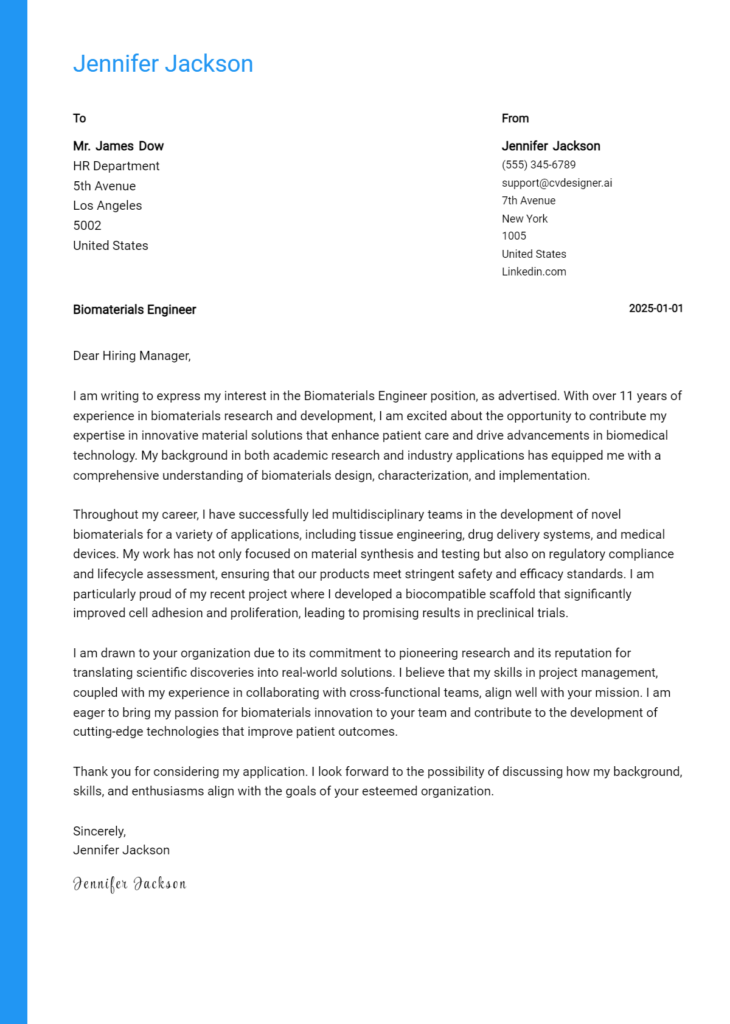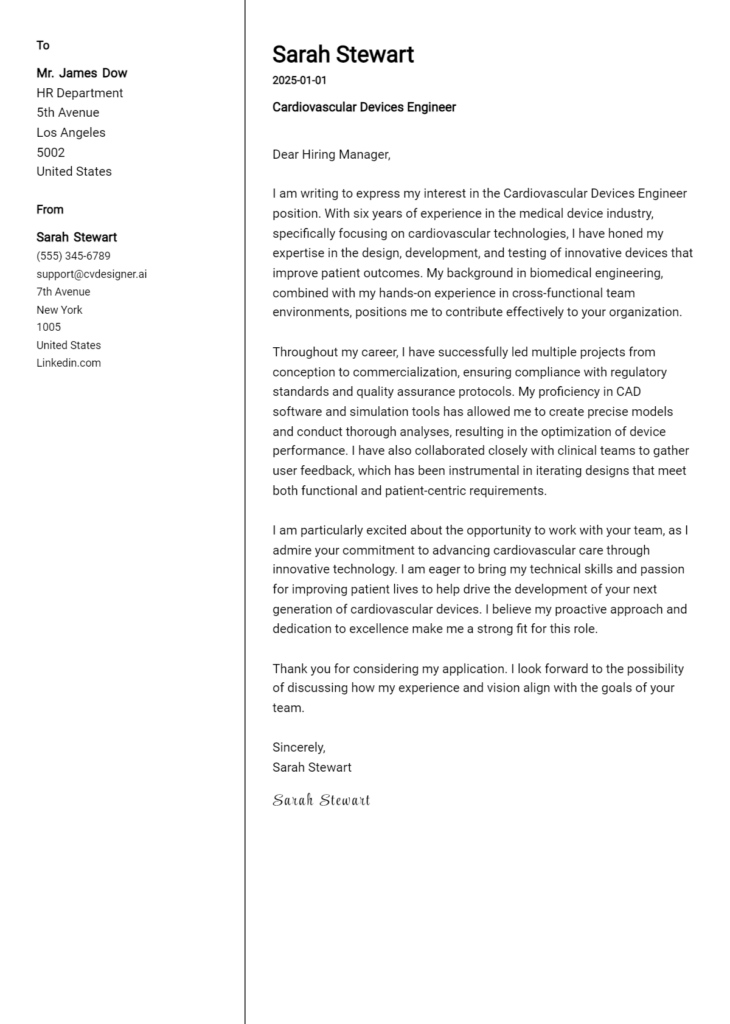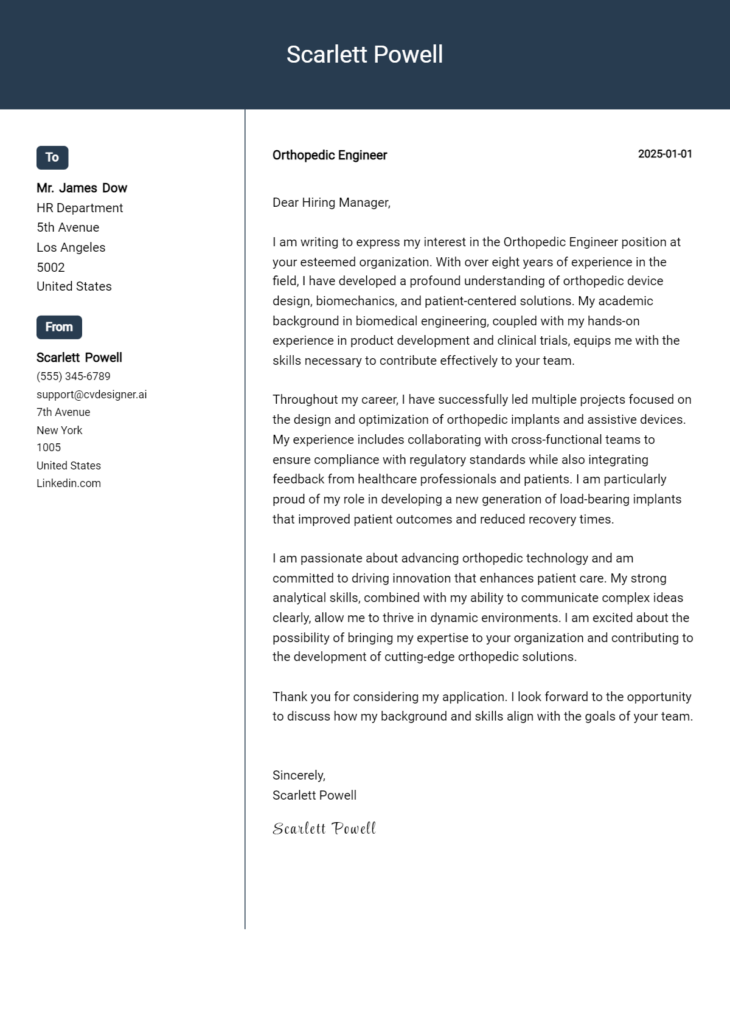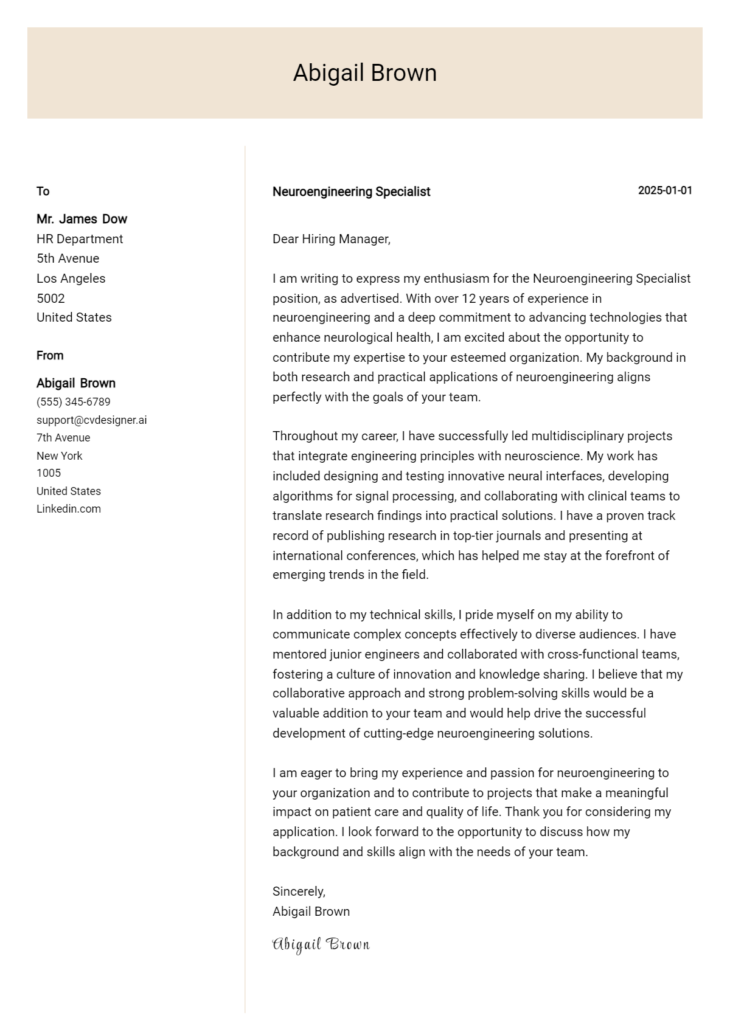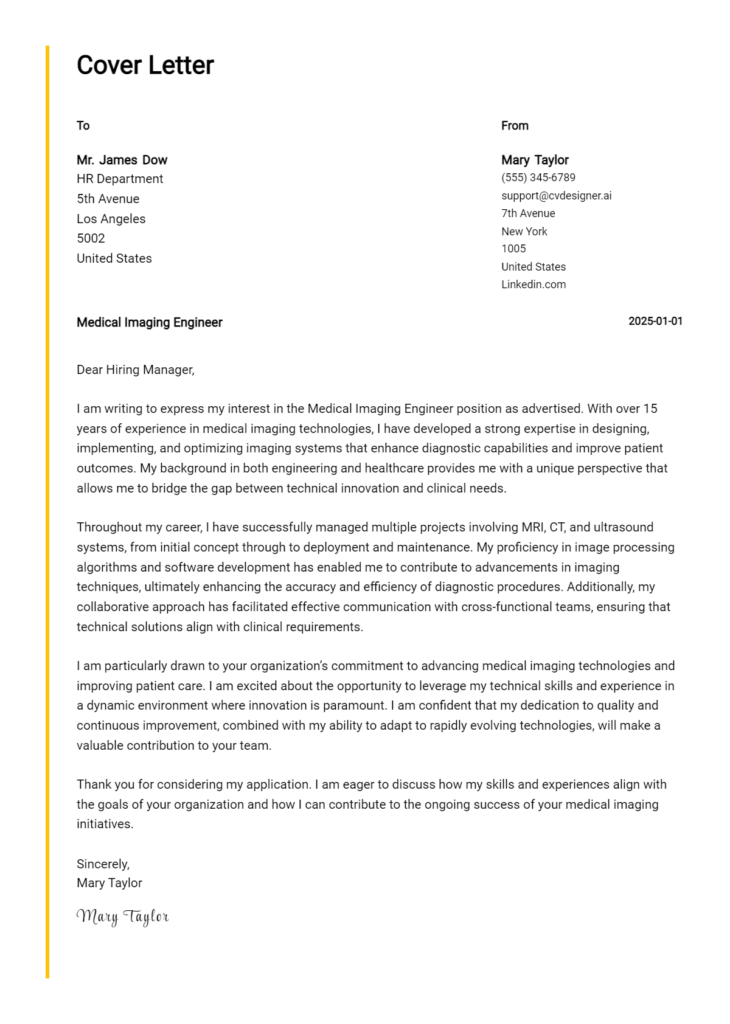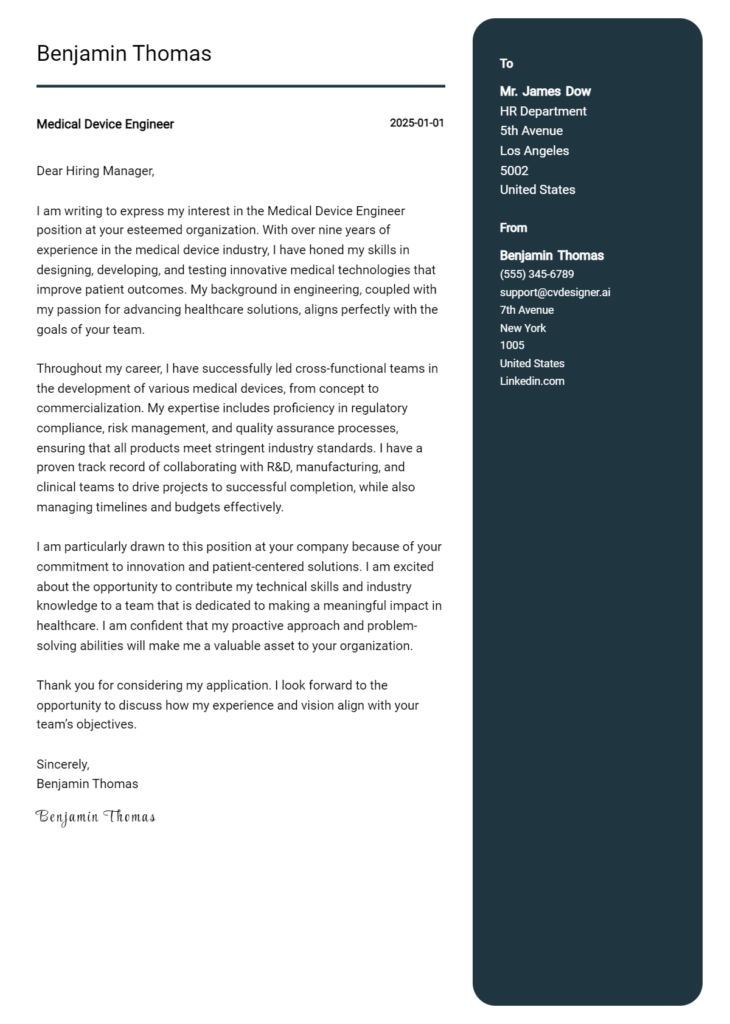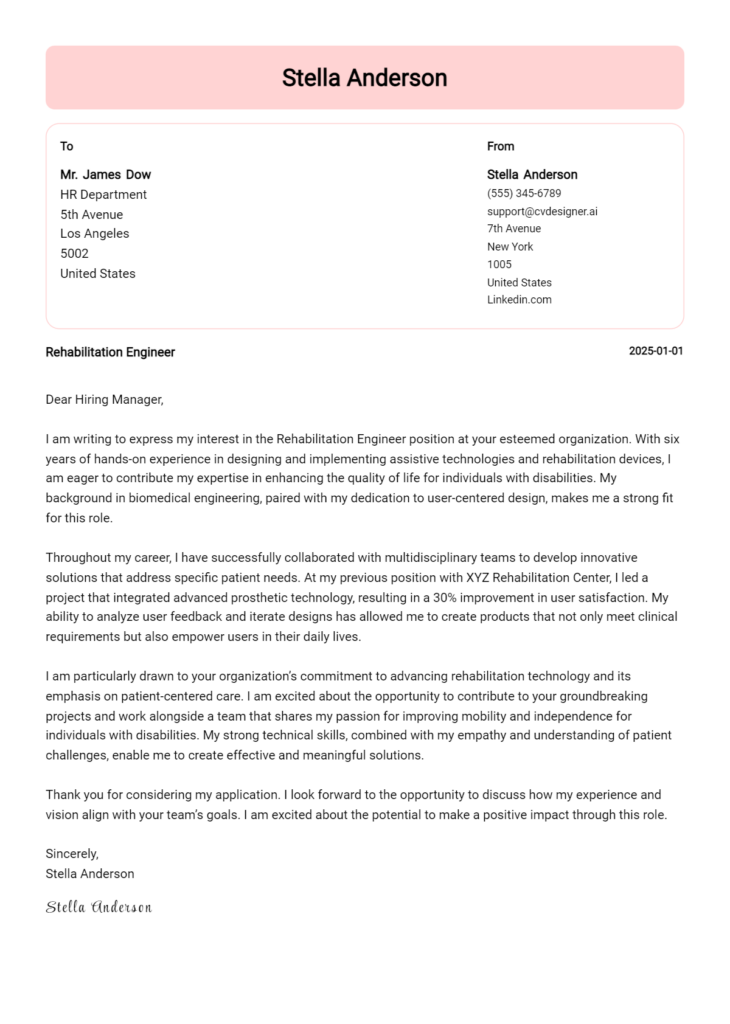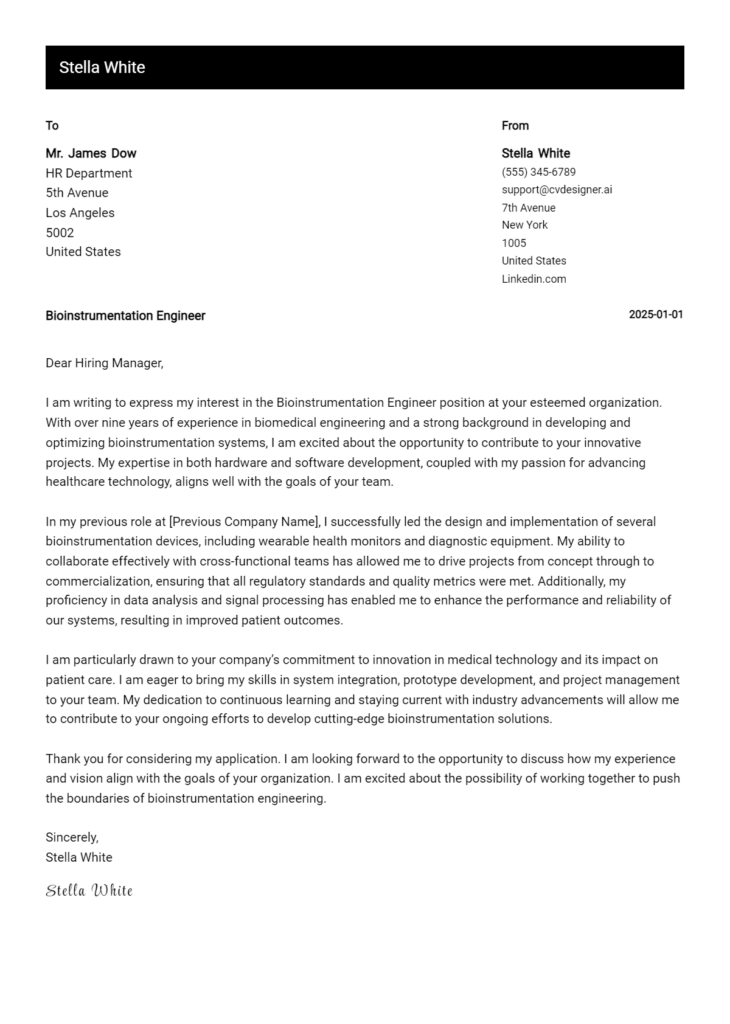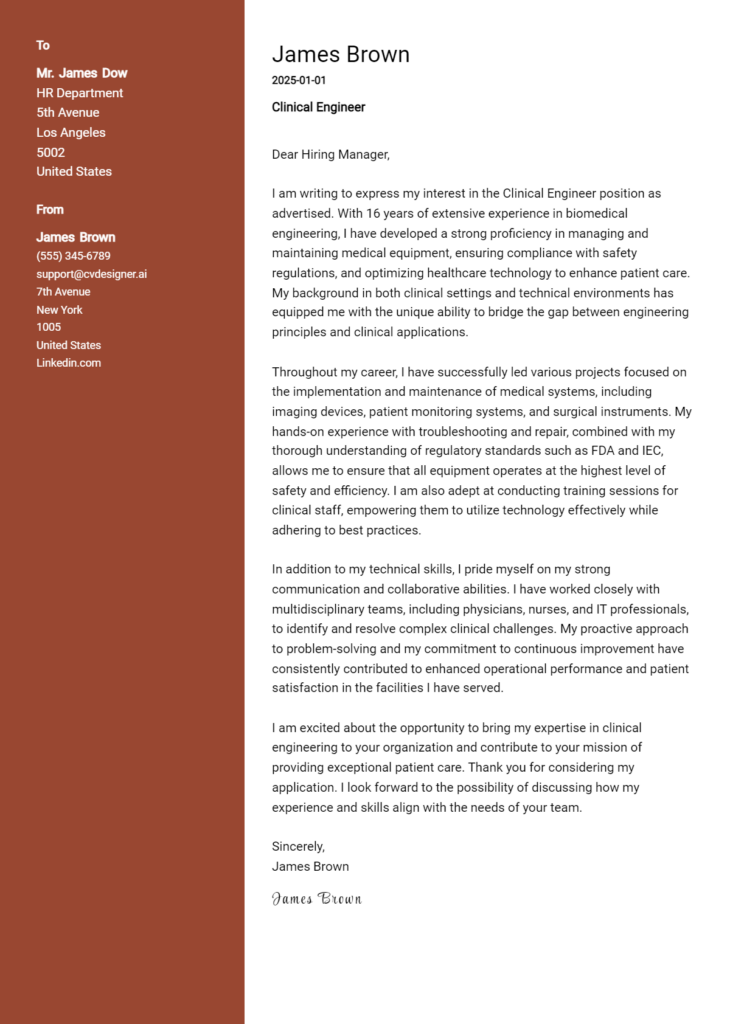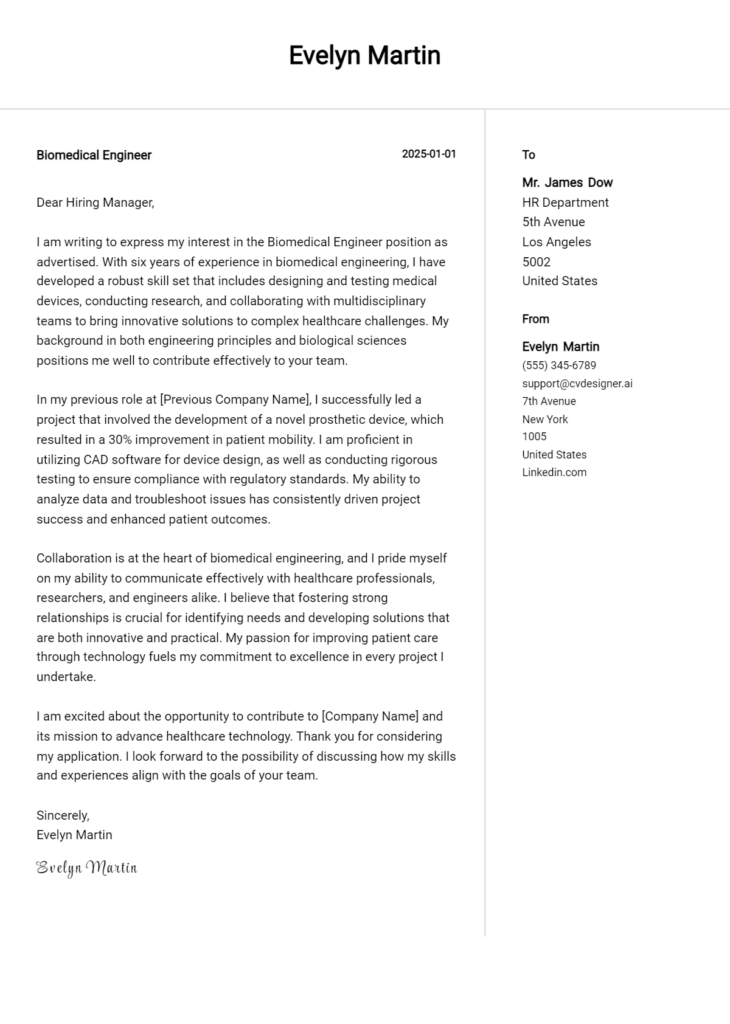Biomechanical Engineer 2 Cover Letter Examples
Explore additional Biomechanical Engineer 2 cover letter samples and guides and see what works for your level of experience or role.
How to Format a Biomechanical Engineer Cover Letter?
Crafting a compelling cover letter is essential for a Biomechanical Engineer, as it not only showcases your technical expertise but also reflects your ability to communicate complex ideas clearly and effectively. The way you format your cover letter can significantly influence the impression you make on hiring managers, highlighting your attention to detail and organizational skills—critical attributes in the field of biomechanics.
In this guide, we will explore how to structure your cover letter, offering insights and biomechanical engineering-specific examples to assist you in creating a persuasive document.
We’ll focus on the essential components of a professional cover letter, including:
- Cover Letter Header
- Cover Letter Greeting
- Cover Letter Introduction
- Cover Letter Body
- Cover Letter Closing
Each section plays a crucial role in emphasizing your qualifications and professional demeanor. Let’s break down each part and explain how to make your biomechanical engineer cover letter stand out.
Importance of a Cover Letter Header for a Biomechanical Engineer
A well-crafted cover letter header is crucial for a Biomechanical Engineer as it sets the tone for the entire document and conveys professionalism. The header should include essential contact information, the date, and the recipient's details to ensure clarity and facilitate communication. An effective header not only presents the applicant in a positive light but also demonstrates attention to detail—an important skill in the engineering field.
Here are examples of a strong and weak cover letter header for a Biomechanical Engineer:
Strong Example
John Doe 123 Engineering Lane Innovative City, CA 90210 (123) 456-7890 johndoe@email.com October 1, 2023 Dr. Jane Smith Hiring Manager BioTech Solutions 456 Research Blvd Innovative City, CA 90211
Weak Example
John D. Somewhere, USA 12345 No Phone 10/1/23 To Whom It May Concern
The Importance of a Strong Cover Letter Greeting for Biomechanical Engineers
The greeting in a cover letter serves as the first impression for the reader and sets the tone for the entire message. A well-crafted greeting not only demonstrates your professionalism but also adds a personal touch by addressing the hiring manager directly. This approach shows that you have taken the time to research the company and the individual to whom you are applying, which can help you stand out among other candidates. To enhance your greeting, avoid generic phrases such as "To Whom It May Concern" and instead strive to find the hiring manager's name through company websites or LinkedIn. Personalizing your greeting can significantly impact the reader’s perception of your application.
Strong Greeting Example
Dear Dr. Jane Smith,
Weak Greeting Example
To Whom It May Concern,
The Importance of a Strong Cover Letter Introduction for a Biomechanical Engineer
A well-crafted cover letter introduction is crucial for a Biomechanical Engineer as it sets the tone for the entire application and serves as the first impression to the hiring manager. This initial paragraph should not only capture attention but also convey genuine enthusiasm for the role while briefly highlighting key skills or relevant achievements that make the candidate a strong fit. A compelling introduction can differentiate a candidate in a competitive job market, making it essential to strike the right balance between professionalism and personality.
Strong Example
Dear [Hiring Manager's Name], As a passionate and dedicated Biomechanical Engineer with over five years of experience in designing innovative orthopedic devices, I was thrilled to discover the opportunity at [Company Name]. My background in advanced materials and biomechanics, combined with a proven track record of leading successful projects that improved patient outcomes, makes me excited about the possibility of contributing to your team. I am particularly impressed by [specific project or value of the company], and I am eager to bring my expertise to help advance your mission.
Weak Example
To Whom It May Concern, I am writing to apply for the Biomechanical Engineer position. I have a degree in engineering and some experience in the field. I believe I could do well in this job, and I hope you will consider my application.
Purpose of the Cover Letter Body for a Biomechanical Engineer
The body of a cover letter for a Biomechanical Engineer serves to succinctly outline the candidate's relevant skills, experiences, and the unique value they bring to the prospective company. This section is an opportunity to highlight specific projects or accomplishments that demonstrate the candidate's technical expertise, problem-solving abilities, and innovative thinking in the field of biomechanics. By presenting concrete examples of past work, such as successful collaborations on prosthetic design or contributions to research in tissue engineering, candidates can effectively illustrate how their background aligns with the company’s goals and needs.
Strong Example
In my previous role at XYZ Biomechanics, I led a project that developed an advanced prosthetic limb utilizing smart materials to enhance user comfort and mobility. This project not only improved the functional outcomes for patients but also resulted in a 30% reduction in manufacturing costs. My collaboration with cross-functional teams allowed us to implement a user-centered design approach, which significantly increased patient satisfaction ratings. With my solid foundation in both mechanical engineering principles and biological systems, I am excited about the opportunity to contribute to your team’s innovative projects at ABC Corporation.
Weak Example
I have worked in the field of engineering for a few years and have some experience with medical devices. I am interested in the position because I think it would be a good opportunity. I have done some projects, but I cannot remember the details right now. I believe I can help your company with my engineering skills.
Importance of the Cover Letter Closing for a Biomechanical Engineer
The closing paragraph of a cover letter is crucial as it encapsulates the candidate's qualifications, expresses enthusiasm for the position, and prompts the employer to take action, such as reviewing the resume or scheduling an interview. A strong closing reinforces the applicant's fit for the role and leaves a lasting impression, while a weak closing can diminish the overall impact of the letter. Here are examples of both:
Strong Example
Thank you for considering my application for the Biomechanical Engineer position at [Company Name]. With my extensive background in biomechanics, coupled with my passion for innovative design solutions, I am excited about the opportunity to contribute to your team. I believe my skills in [specific skills] align well with your needs, and I look forward to discussing how I can support your projects. I hope to speak with you soon to further explore this opportunity.
Weak Example
I hope you like my application. I think I would be okay for the Biomechanical Engineer job. Please look at my resume if you want. Thanks for your time.
Crafting an effective cover letter is essential for Biomechanical Engineer candidates looking to stand out in a competitive job market. A well-written cover letter not only highlights your technical skills but also emphasizes your problem-solving abilities, familiarity with the Software Development Life Cycle (SDLC), teamwork, and a strong commitment to continuous learning. Here are some tips to help you showcase these qualities and create a compelling cover letter.
Tips for Writing a Cover Letter as a Biomechanical Engineer
Highlight Your Technical Skills
Clearly outline your technical competencies relevant to biomechanics. Include specific software tools (like MATLAB, SolidWorks, or ANSYS) and methodologies you are proficient in. Demonstrating your technical expertise early in the letter can capture the hiring manager's attention and set a strong foundation for your candidacy.Showcase Problem-Solving Abilities
Use examples from past projects or experiences where you identified a problem and implemented a solution. This could involve optimizing a design, improving a process, or developing a new product. Frame your story using the STAR method (Situation, Task, Action, Result) to clearly illustrate your impact.Demonstrate Knowledge of the SDLC
If the position involves software development, discuss your understanding of the Software Development Life Cycle. Mention any experience you have with Agile methodologies or other SDLC frameworks. This knowledge can help you communicate more effectively with cross-functional teams and shows that you can contribute to software-related projects.Emphasize Teamwork and Collaboration
Biomechanical engineering often requires working in multidisciplinary teams. Share examples of successful collaborations with engineers, healthcare professionals, or researchers. Highlight your ability to communicate complex ideas clearly and how you contributed to team success, reinforcing your interpersonal skills.Express a Passion for Continuous Learning
The field of biomechanics is constantly evolving. Highlight your commitment to staying updated with the latest technologies, trends, and research. Mention any relevant certifications, workshops, or courses you’ve undertaken. This not only shows your dedication but also your proactive approach to professional development.
By following these tips, you can craft a cover letter that effectively communicates your qualifications as a Biomechanical Engineer. For additional resources, consider exploring cover letter templates or utilizing a cover letter builder to streamline the writing process.
Common Mistakes to Avoid in a Biomechanical Engineer Cover Letter
Crafting a compelling cover letter is essential for standing out in the competitive field of biomechanical engineering. Avoiding common mistakes can significantly enhance your chances of landing an interview. Here are several pitfalls to watch out for:
Generic Language: Using a one-size-fits-all approach can turn off employers. Tailor your cover letter to the specific job by incorporating keywords from the job description.
Focusing on Responsibilities, Not Achievements: Listing job duties without highlighting your accomplishments can make your application forgettable. Emphasize specific projects or results you've achieved in previous roles.
Neglecting Formatting: A poorly formatted cover letter can distract from your qualifications. Ensure your document follows a clear cover letter format that is easy to read and visually appealing.
Spelling and Grammar Errors: Typos can undermine your professionalism. Always proofread your cover letter or ask someone else to review it before submission.
Lack of Enthusiasm: A cover letter that feels flat or unenthusiastic can signal a lack of interest in the role. Show your passion for biomechanical engineering and the specific position to engage the reader.
Overly Technical Language: While it's important to demonstrate your expertise, using excessive jargon can alienate hiring managers. Aim for clarity and make your technical skills accessible.
Failing to Include a Call to Action: Concluding without a strong call to action can leave the reader unsure of your intentions. Encourage the hiring manager to reach out for further discussion about your qualifications.
For inspiration, check out some cover letter examples that effectively demonstrate these principles.
Cover Letter FAQs for Biomechanical Engineer
What should I include in my cover letter as a Biomechanical Engineer?
When crafting your cover letter, include a brief introduction that states the position you’re applying for and where you found the job listing. Highlight your relevant education, such as a degree in biomechanical engineering or a related field, and mention any specific projects or research that align with the job description. Discuss your technical skills, such as proficiency in CAD software, finite element analysis, or biomechanics modeling, and how they can contribute to the company’s goals. Finally, express your enthusiasm for the role and the company, and conclude with a call to action, inviting the hiring manager to discuss your application further.
How can I demonstrate my technical skills in my cover letter?
To effectively demonstrate your technical skills, provide specific examples from your academic or professional experience that showcase your expertise. Mention projects where you applied biomechanical principles to solve real-world problems, such as designing prosthetics, developing orthopedic devices, or conducting experiments in labs. Use quantifiable results to illustrate your impact, such as improving a device's efficiency by a percentage or reducing production costs. Additionally, you can reference any software or tools you used, such as SolidWorks or MATLAB, to show your familiarity with industry standards. Tailor these examples to align with the requirements outlined in the job description.
Should I include my research experience in the cover letter?
Yes, including your research experience is beneficial, especially in a technical field like biomechanical engineering. Highlight any relevant research projects you’ve participated in, detailing your role and contributions. Explain how your research skills, such as data analysis or experimental design, relate to the position you’re applying for. If you published papers or presented at conferences, mention these achievements as they demonstrate your commitment to the field and your ability to communicate complex ideas. Tailor your research experiences to the job, emphasizing how they equip you with unique insights or skills that would be valuable to the prospective employer.
How long should my cover letter be for a Biomechanical Engineer position?
Your cover letter should ideally be one page long, consisting of three to four paragraphs. Aim for around 250 to 400 words, ensuring that each section is concise and impactful. Start with a strong introduction, followed by a paragraph that details your relevant experience and skills. Use another paragraph to discuss your technical expertise or research, linking it to the specific needs of the position. Finally, conclude with a brief summary of your enthusiasm for the role and a call to action, inviting the hiring manager to contact you for further discussion. Keeping it concise allows hiring managers to quickly grasp your qualifications and interest.
Build your Cover Letter in minutes
Use an AI-powered cover letter builder and have your letter done in 5 minutes. Just select your template and our software will guide you through the process.

